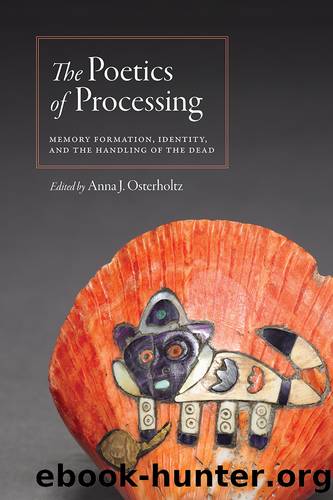The Poetics of Processing by Anna J. Osterholtz

Author:Anna J. Osterholtz [Osterholtz, Anna J.]
Language: eng
Format: epub
ISBN: 9781646420612
Barnesnoble:
Publisher: University Press of Colorado
Published: 2020-12-01T00:00:00+00:00
8
Social Memory and Mortuary Practices in Neolithic Anatolia
Marin A. Pilloud, Scott D. Haddow, Christopher J. Knüsel, Clark Spencer Larsen, and Mehmet Somel
The Neolithic is a cultural designation that is generally associated with the domestication of plants and animals. In the Near East, its earliest origins appear with plant domesticates beginning at 10,700 cal BP (Fuller, Willcox, and Allaby 2012; Willcox 2012). The earliest domestication of ungulates in this region is thought to have occurred in an area extending from southeastern Anatolia to Iran between 8500 and 7000 BC (Vigne 2008; Zeder 2008, 2011). Concomitant with this domestication of plants and animals comes the development of settled life and agglomerated villages that signal a changing relationship with the âbuilt environmentâ (Watkins 2006; Zeder 2015, 5), thus constituting the broad changes associated with the âNeolithic Revolutionâ (sensu Childe 1936). Recently, researchers have addressed the variability within this process and moved away from the simplistic notion of a ârevolution.â Instead, research is focused on how neolithization occurred in a nonlinear fashion (Sterelny and Watkins 2015).
While this radical cultural change likely varied greatly in time and place, the âNeolithic packageâ has been defined as a cultural construct that included domesticated plants and animals, as well as similarities in artifacts, settlement type, and symbolic representation (Ãilingiroglu 2005; ÃzdoÄan 2010). The initial development of this package can be seen in the core area, extending from the Levant to Anatolia, where it paused for nearly two millennia before moving to the Aegean basin (Brami 2015), and paused again for another two millennia before progressing further outward (ÃzdoÄan 2008, 2011). This substantial pause allowed for a protracted period of development of Neolithic culture (Düring 2013). As neolithization spread westwards and out of the core area, it adapted and changed, although much of what came later could find its origin in this initial core area (ÃzdoÄan 2010). Of particular interest is the similarity in mortuary practices seen early on in this core area, which included intramural burial and, in many cases, some manner of secondary manipulations of skeletal elements, to include cranium/skull removal and caching and/or disturbances of previous interments. While these practices had their root in earlier preagricultural societies in the Levant during the Natufian, they become more widely spread during the Neolithic in the Near East (Kuijt 1996). Then, as the Neolithic transitions to the subsequent Chalcolithic and the âNeolithic packageâ moves westward, these practices become less visible in the archaeological record (ÃzdoÄan 2010). The development and growth of these practices from the Natufian to the Neolithic point to an intimate association with death and the dead, an association that may have been critical in maintaining social stability during the transition to agriculture. These mortuary practices may have served as a means of reinforcing social memory, which may have been critical in the rise of socioeconomic complexity and the interaction between these communities and the landscape and its resources.
While much work has been done on the Neolithic and Natufian periods in the Levant, less research has focused on Anatolia as a key location in the development of the Neolithic (see Watkins 2016).
Download
This site does not store any files on its server. We only index and link to content provided by other sites. Please contact the content providers to delete copyright contents if any and email us, we'll remove relevant links or contents immediately.
| Africa | Americas |
| Arctic & Antarctica | Asia |
| Australia & Oceania | Europe |
| Middle East | Russia |
| United States | World |
| Ancient Civilizations | Military |
| Historical Study & Educational Resources |
Machine Learning at Scale with H2O by Gregory Keys | David Whiting(4172)
Never by Ken Follett(3787)
Fairy Tale by Stephen King(3216)
The Man Who Died Twice by Richard Osman(2995)
Oathbringer (The Stormlight Archive, Book 3) by Brandon Sanderson(2871)
Will by Will Smith(2790)
Rationality by Steven Pinker(2290)
The Dark Hours by Michael Connelly(2243)
Can't Hurt Me: Master Your Mind and Defy the Odds - Clean Edition by David Goggins(2225)
The Dawn of Everything: A New History of Humanity by David Graeber & David Wengrow(2122)
Friends, Lovers, and the Big Terrible Thing by Matthew Perry(2116)
Principles for Dealing With the Changing World Order: Why Nations Succeed and Fail by Ray Dalio(1969)
HBR's 10 Must Reads 2022 by Harvard Business Review(1776)
A Short History of War by Jeremy Black(1758)
Go Tell the Bees That I Am Gone by Diana Gabaldon(1685)
515945210 by Unknown(1598)
A Game of Thrones (The Illustrated Edition) by George R. R. Martin(1587)
Kingdom of Ash by Maas Sarah J(1521)
443319537 by Unknown(1466)
